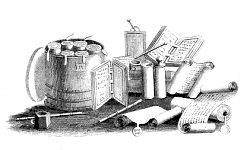Vignette 29
|
This vignette, though not existing in any one place as a painting at Pompeii, may nevertheless be considered antique, as it consists of a union of all the usual implements of writing collected from a great number of ancient paintings in the two ruined cities, and some from the chamber supposed to have been the library of the tragic poet of Pompeii. This idea arose from the impression that every painting was appropriate to the chamber in which it was found. |
On the left is a circular wooden or metal case, with a
lid, containing six books or volumes rolled up and labelled,
each according to its contents, so as to be easily
distinguished. Below this lies a stylus and a pentagonal
inkstand, not unlike those now in common use. The ink was
called atramentum and atramentum scriptorium,
and the inkstand atramentarium, and even
cornugraphium. In the centre lies a pen made of a
reed, and thence called calamus.
Ink seems to have been made with charcoal, but sometimes also
with sepia : «Sepia lympha». Persius, Sat. III.
That author describes an idle boy, who excuses himself from
writing because the sepia is too thick, and, on its being
diluted with water, because it was then too pale. It seems to
have been of such a nature, without a mordent, that a
punica spongia, according to Martial, washed out the
writing ; and some have conjectured that certain sorts of
paper were covered with a species of whitewash to render this
operation more easy, and make the paper serviceable a second
tune. This would be more readily performed when the writing
was upon ivory, or libri elephantini, mentioned also
by Martial. This expunging of writing was so common, that a
friend of Augustus asking him how his tragedy of Ajax was
proceeding, was told by the emperor, who was tired of writing
and had destroyed his work, that «ajacem suam in
spongiam incubuisse». Suetonius, who relates this
story, adds one of Caligula, which shows that the ink of the
ancients was easily obliterated, for he says that the emperor
forced those who had written any thing against him to lick it
out with their tongues.
Next to the case of books, the vignette has the
tabella or tabulae joined together as with
hinges, and sometimes, perhaps always, covered with wax.
Another sort is hung up above this, where the stylus serves
as a pin to hang it up against the wall. A sort of thick book
of tablets, open, lies to the right of the last. In the
centre are seen single volumes in cases, one of which is open
on the loft and the other shut. On the right are seen four
volumes, lying in such a manner as to want no explanation,
two of which have their titles, one attached to the papyrus
itself, and the other from the umbilicus, or cylinder of Wood
in its centre.
Tablets were sometimes made of fine wood polished, but those
in common use were of box, and the wax, from frequent use,
became discoloured and dirty.
«Vulgari buxo sordida cera fuit». PROPERTIUS.
Though many wrote in wax, «facillima delendi»,
as Quintilian says, paper was so common that pepper,
frankincense, and other articles are mentioned as wrapped up
in useless manuscripts, as they are now in a country
shop.
With regard to a stylus, it was prohibited at certain
periods, as a penknife is in modern Italy, on account of its
affording a ready means of revenge to an angry possessor. It
was called stylus or graphium. With a stylus
Cassius struck Cesar. Suetonius says, also, that Caligula
caused an obnoxious senator to be massacred with one ; and
that, in the reign of Claudius, women and pueri
pretextati had been searched for styles in their
graphiariae thecae, or pencases. It seems that wax,
tablets, codex, liber, folio, membrane, charta, and papyrus
were not, in common conversation, clearly distinguished in
the Augustan age,when writing became in frequent and ordinary
use. We find the names of many sorts of paper corresponding
with our foolscap, elephant, and other sizes, with their
measures and the directions for their manufacture.
There was the hieratica or sacra, the
augusta, the liviana, the
amphitheatrica, the famia, the saitica,
the regia, and the macrocolum, and common waste
paper, or amphoretica.
The quantity must have been very much like what would be
found in a great city of our own times ; and Pliny left one
hundred and sixty volumes, opisthographos et
minutissime scriptos, or written very minutely on both
sides, to his nephew.
MSS. of papyrus were capable of resisting the attacks of time
and worms longer than we might imagine. The papers of
Tiberius and Caius Gracchus were kept by Pomponius Secundus,
Vates, and were nearly 200 years old when seen by Pliny. The
same author says he had often seen the monuments, or books of
Cicero, Virgil, and Augustus. Galen, speaking of MSS. of
Hippocrates, considers 300 years as a vast antiquity. St.
Jerome mentions that, in 100 years, the libraries of Origen
and Pamphilus, at Caesarea, were already nearly worn out and
corrupted ; but the Bishop of St. David's assigns to the
Alexandrine MS. in the British Museum an antiquity of 1300 or
1400 years. This, however, is probably one of those in
Membranis.
